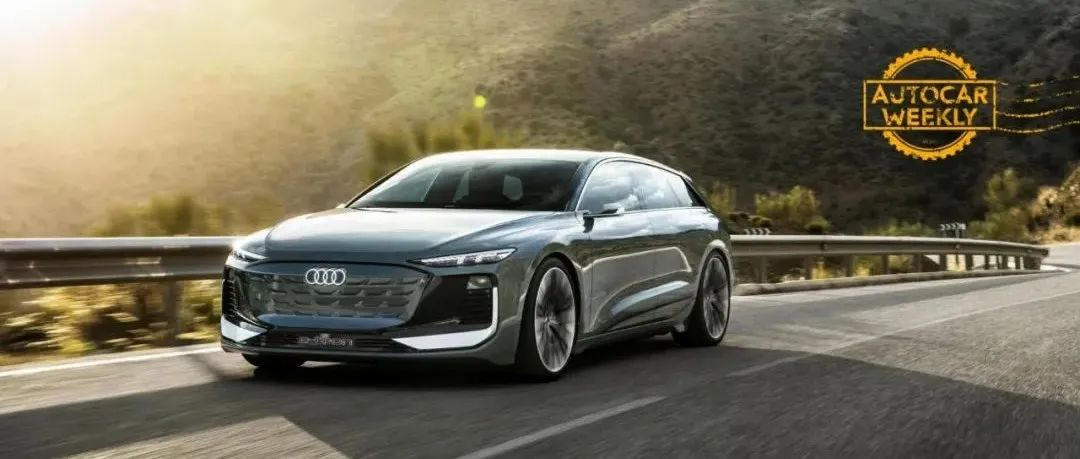Title: New electric vehicles from Audi China
In February, the Audi Q5 e-tron was officially launched on the MEB electric platform, becoming the first MEB electric vehicle released by Audi China. Next up, the more “original” FAW-Volkswagen Audi Q4 e-tron will follow in the coming months. The two models are from two different Chinese Volkswagen joint ventures, with one having a two-row five-seater configuration while the other has three rows seating seven, offering a comfortable fit for a wide range of customers.
After more than a year since the debut of the ID. series with Volkswagen badges, the Audi pure battery electric vehicle (BEV) based on the same MEB platform needs to convince customers to spend more money. However, this window for persuasion may not last long, as the Audi brand’s “true” platform will arrive soon.
If it were not for the pandemic, the A6 Avant e-tron concept car would have been one of Audi’s highlights at the Beijing Auto Show in March. Both the A6 Avant e-tron and the A6 e-tron concept car from last year are based on the brand’s high-end PPE electric platform, which is exclusive to Audi. The first MEB electric vehicle from Audi, the Q4 e-tron, was produced soon after the release of the Sportback concept car.
According to plan, FAW-Volkswagen Audi’s PPE production line in Changchun will be ready next year, with the first batch of production models A6 e-tron and Q6 e-tron (not to be confused with the SAIC-Audi Q6) expected to be unveiled later this year.
Audi’s current pure electric transformation plan includes four vehicle platforms. The more familiar e-tron SUV comes from the MLB Evo platform, while the upcoming e-tron GT, which has been “coming soon” for a long time, shares the J1 platform with the Porsche Taycan. Both are closely related to combustion engine platforms or general platforms and will not be used for more models. Two truly pure electric platforms are the MEB platform shared with Volkswagen’s ID series and the PPE platform developed jointly with Porsche and positioned as a high-end platform that is not expected to use Volkswagen badges. The first production versions of the A6 e-tron and Q6 e-tron will arrive on the PPE platform.You can think of it as an advanced version of MEB, or as a “more pure electric” (while slightly more practical) J1.
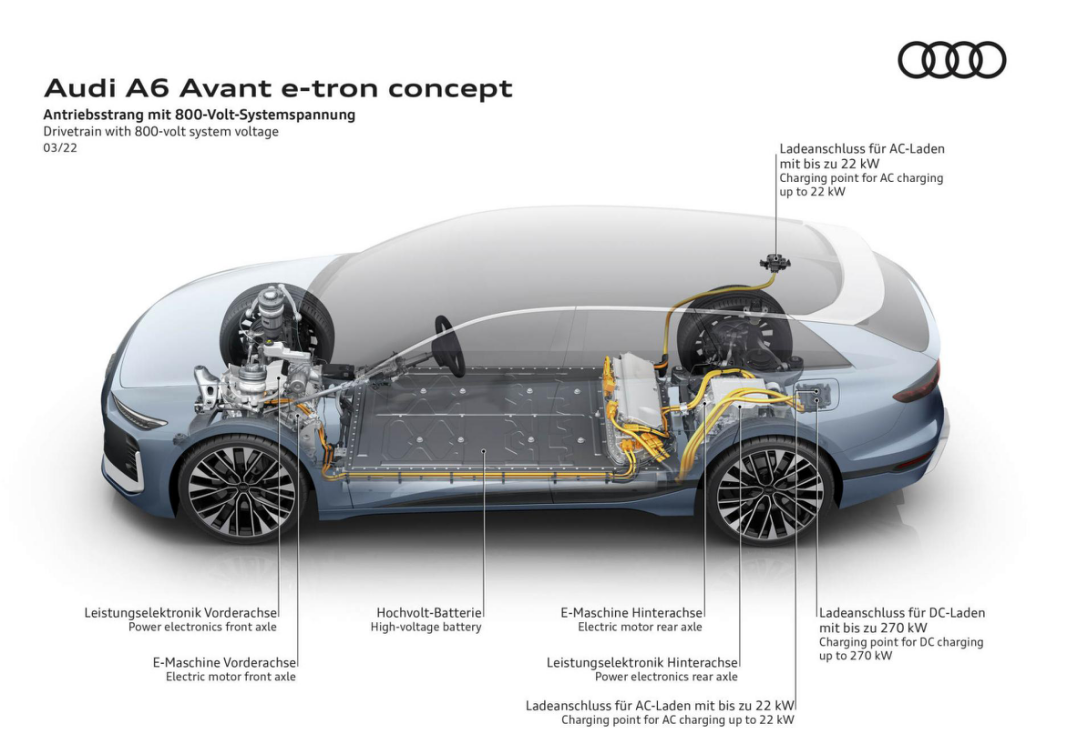
Compared with MEB, the PPE platform is more suitable for mid-to-high-end models in terms of body form.
The PPE provides a longer wheelbase range of 2890-3080mm, while the largest wheelbase size of the ID.6/Q5 e-tron on the MEB platform is 2965mm, which can be considered as the limit of the MEB platform. Considering the relative relationship between wheelbase and price, the A6 e-tron may be the “lower limit” of the PPE platform, and the specific location of this lower limit can be referred to the prefix “A6”.
MEB platform basically only needs to provide space-oriented models such as sedans and SUVs, but mid-to-high-end models’ pursuit of sport performance requires the PPE platform to be able to adapt to a certain degree of coupe-style body. The height setting range of the PPE ground clearance is between 152-217mm. Considering the support of air suspension, it can adapt to a product sequence from coupe cars to high-end SUVs.
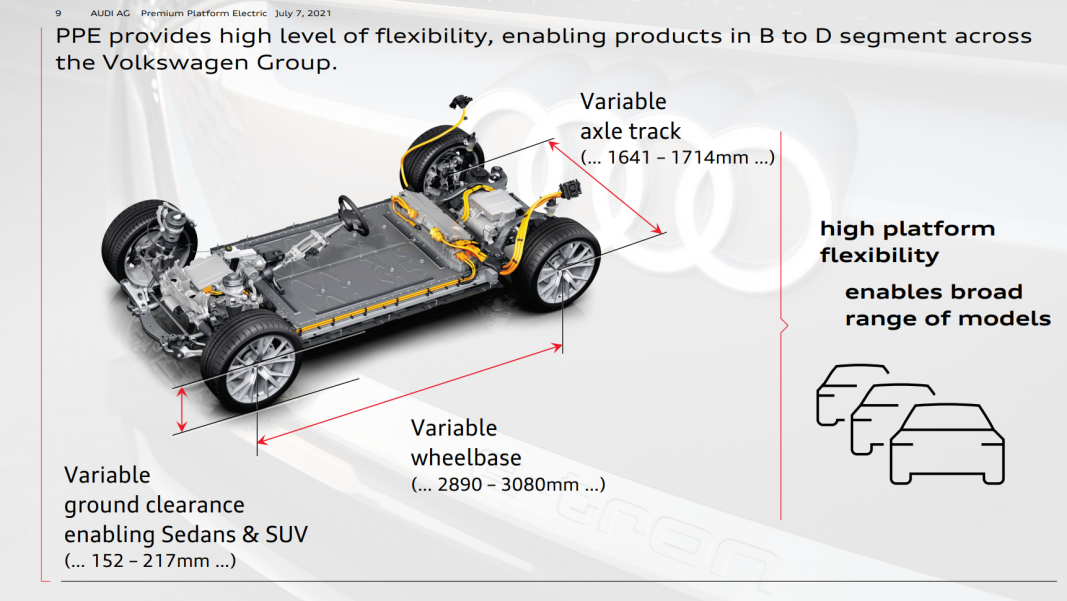
On the J1 platform, in order to prevent the chassis battery pack from affecting the rear seating space and damaging the roof contour, Porsche and Audi have adopted the “footwell” design. However, the cost of the “footwell” is the loss of usable battery space. Taycan and e-tron GT can only obtain up to 93kWh even with a 2.9-meter wheelbase. At the same time, the foot position of the driver’s seat is relatively raised compared to similar fuel vehicles, and the seating posture is restricted.
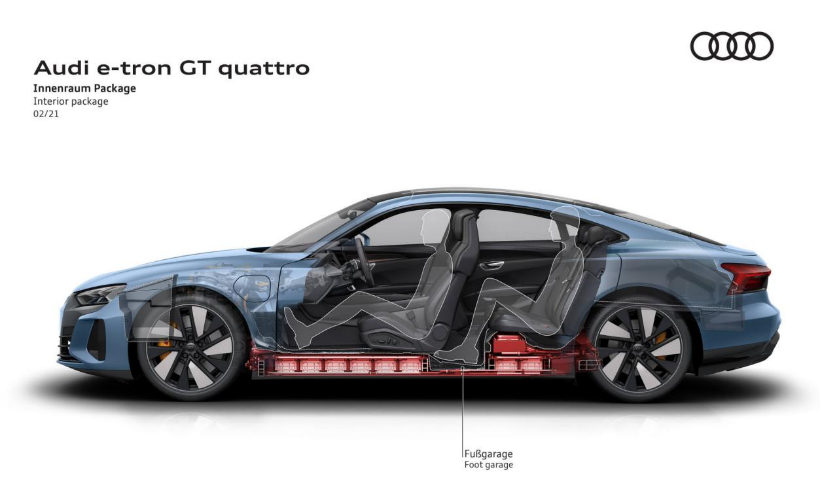
The PPE platform has a regular battery pack shape similar to MEB, as well as the same larger module (12) layout, which supports the battery capacity to increase to 100kWh. In the preview video of the PPE platform, two configurations of low-floor and high-floor (high and low ground clearance) appear, and the height (thickness) of the battery pack also varies, which may provide different battery thickness settings for sedans and SUVs.
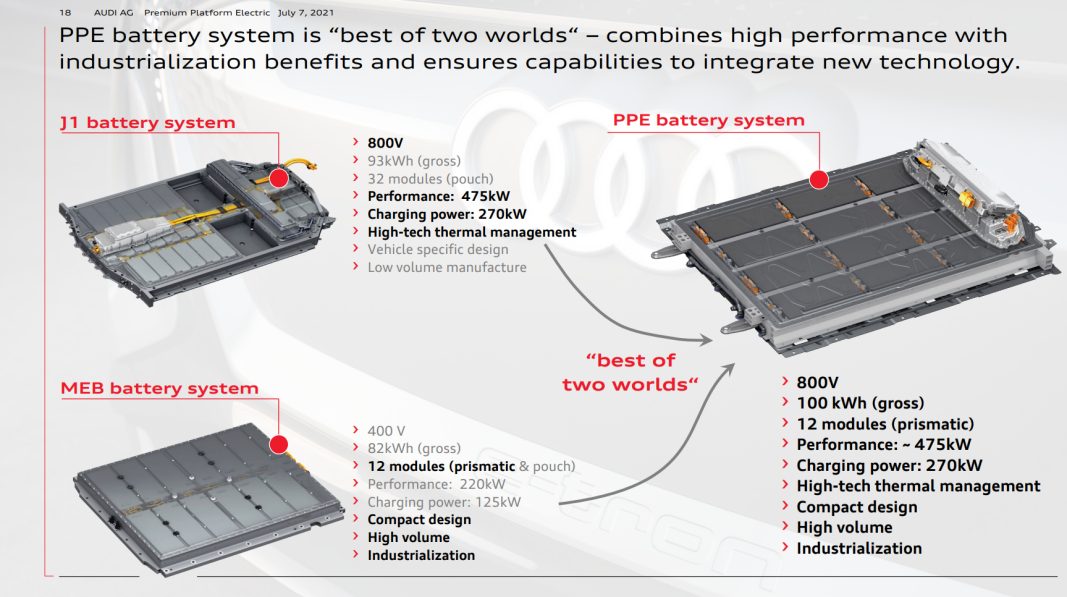 Similar to the MEB platform, but unlike the J1 platform, the high-voltage module of the PPE platform is located in a different position. For pure electric vehicles, the charging port is set on the rear body as it is more convenient for reverse charging.
Similar to the MEB platform, but unlike the J1 platform, the high-voltage module of the PPE platform is located in a different position. For pure electric vehicles, the charging port is set on the rear body as it is more convenient for reverse charging.
However, for fuel platform vehicles, the front engine compartment that is emptied out is more ideal as there is more space available. Therefore, the charging port is usually arranged on the front fender. If one insists on having the charging port on the rear body, especially for fast charging, the high-voltage line will need to pass through the entire vehicle from the rear to the front, which will increase weight and cost.
For platform designs initially designed for pure electric vehicles, the high-voltage charging module is often integrated at the rear end of the battery pack, rather than being squeezed into the engine compartment, where there is no huge space reserved for internal combustion engines. The high-voltage charging module of the MEB platform is integrated at the rear motor, while the PPE platform, like the Tesla Model 3, is located under the rear seats.
Therefore, except for the front-wheel-drive configuration, both the MEB and PPE platforms have placed the fast/slow charging port on the rear body. Because of the mainly rear-wheel-drive configuration, the main high-voltage cable in the vehicle does not need to pass through the entire length of the vehicle. This configuration can be said to be the most ideal layout for current pure electric platforms where the high-voltage module is at the rear and the fast charging port is at the rear as well.
As a mid- to high-end platform, PPE also uses 800V high-voltage architecture like the J1 platform, supporting up to 270kW super fast charging, thus achieving the same charging rate as the Taycan. The MEB platform, which pays more attention to economy, is 400V with a maximum charging power of 125kW.
In Europe, Audi has the support of the Ionity charging system, but Audi will need to find other solutions when it comes to China. At present, the Taycan can only enjoy the benefits of the 800V charging speed at a few Porsche-owned supercharging stations. The upcoming PPE platform is not destined to be as niche as some of the J1 platform models and needs high-density support for ultra-high voltage charging systems.
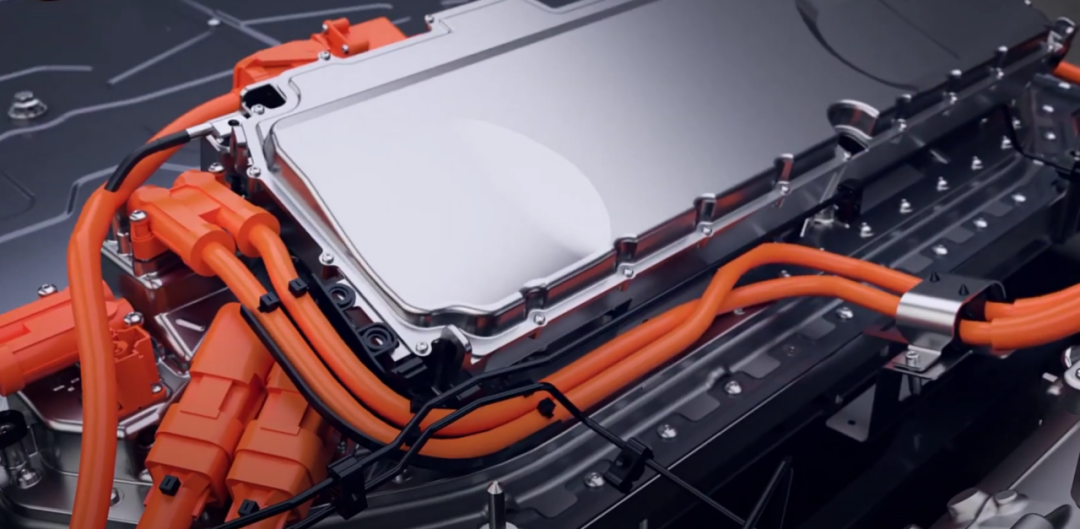
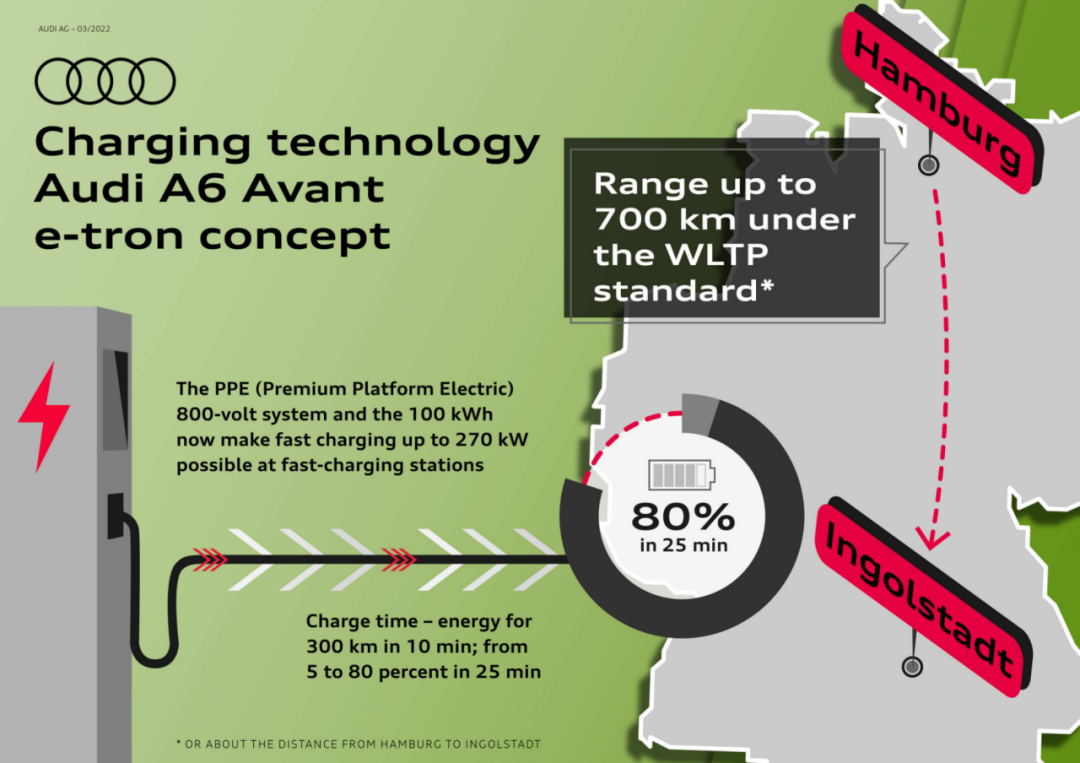
In terms of chassis suspension, the “standard configuration” of the PPE platform is the front and rear five-link structure with adaptive air suspension, which has gradually become a common choice for high-end electric vehicles (see “Electric era, does suspension matter?”). In contrast to the front MacPherson structure adopted by the MEB platform, which attaches great importance to economy, the front five-link suspension of the PPE is more adaptable to the high-power front axle motor, thereby increasing the overall power limit of the four-wheel drive model.
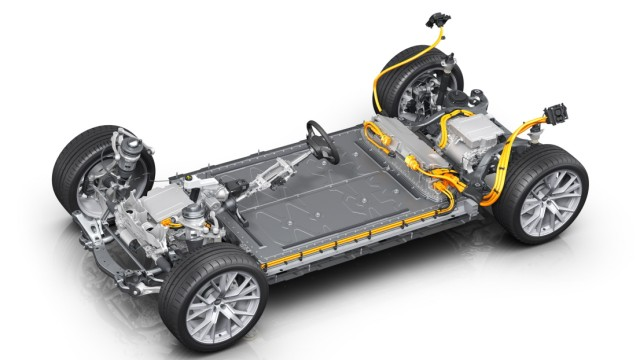
In fact, in addition to the Audi A6 e-tron and Q6 e-tron (which may come with an “L”) to be produced in China next year, another PPE platform model has been confirmed, that is, the next-generation pure electric Porsche Macan. The next-generation Macan will share quite a few body parts with the Q6 e-tron, and the folk tale of “finding the Volkswagen logo on a Porsche in the era of combustion engines” may happen again.
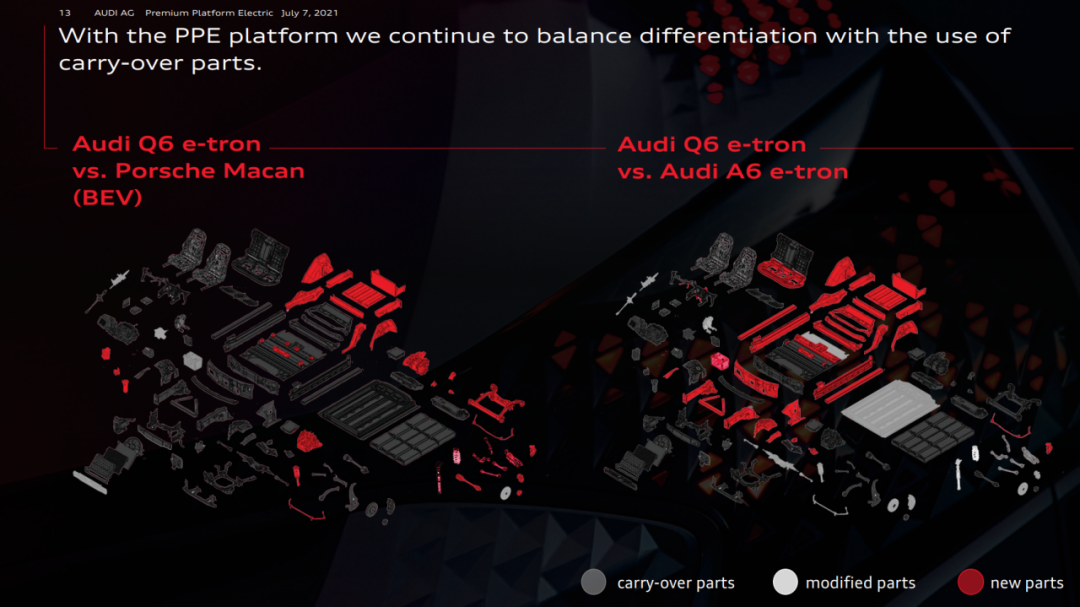
Audi is not the only automaker in the Volkswagen Group who is exploring the electric vehicle market. In addition to BMW, which is taking a different approach in the field of electric vehicles, Mercedes-Benz has also planned two pure electric platforms, EVA (EVA2.0) and MMA. The former has been put into production, used for models such as EQS and EQE, while the latter will be used to create mid-to-low-end models and have a hybrid powertrain of “electric conversion to oil”. Audi’s entry-level platform has been put into mass production, while Mercedes-Benz is leading the way in high-end platforms.
Due to the shared use of the MEB platform with Volkswagen, Skoda, and other brands, Audi’s existing Q5 e-tron and Q4 e-tron face certain market pressure, especially in the case where the Volkswagen ID. series has not fully opened up the market. The MEB platform itself is also diverging, with the emergence of the front-wheel-drive low-cost configuration (MEB21) and the rear four-link configuration (MEB41, ID.Buzz), but it is not yet enough to make Audi’s MEB models stand out.
This is where the PPE platform becomes even more important. The success of the Taycan has already proven that positioning is not an issue, the issue is providing a suitable product in a high-demand market. Mercedes-Benz’s EVA platform is ready, but it will take time to expand downward from the EQS, while new car brands are attacking the broad range of around 400,000 yuan. If Audi’s PPE models can directly enter this market in 2023, it may become the most effective step in Audi’s pure electric strategy.
This article is a translation by ChatGPT of a Chinese report from 42HOW. If you have any questions about it, please email bd@42how.com.
